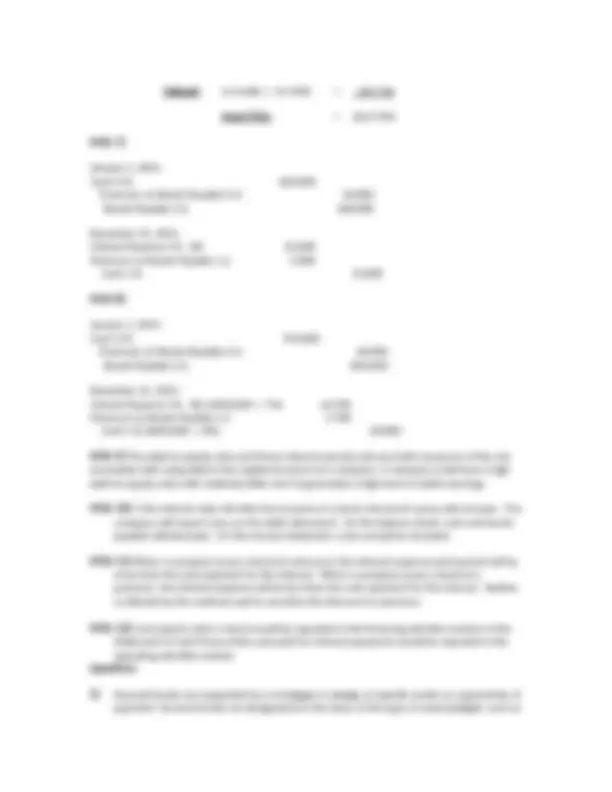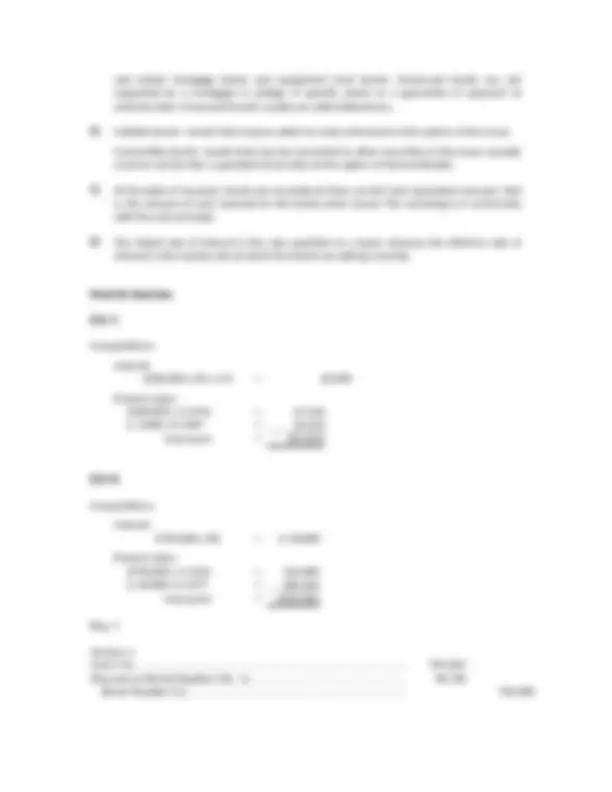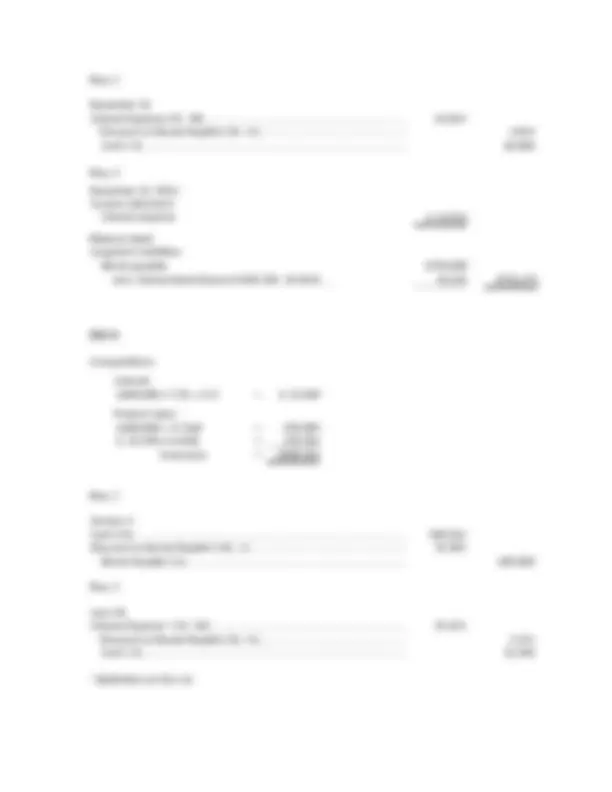





Study with the several resources on Docsity

Earn points by helping other students or get them with a premium plan


Prepare for your exams
Study with the several resources on Docsity

Earn points to download
Earn points by helping other students or get them with a premium plan
Community
Ask the community for help and clear up your study doubts
Discover the best universities in your country according to Docsity users
Free resources
Download our free guides on studying techniques, anxiety management strategies, and thesis advice from Docsity tutors
Notes on various bond-related terms, mini-exercises, and questions related to bonds. Topics covered include bond principles, types of bonds, indenture, bond certificate, trustee, coupon rate, bond premium/discount, amortization methods, and financial ratios. Students can use this document as study notes, summaries, or exercises to better understand the concepts of bonds.
Typology: Study notes
1 / 6

This page cannot be seen from the preview
Don't miss anything!




Chapter 10 notes Vocab Bond Principle- amount payable at the maturity of the bond and on period cash interest payments are computed Per-Value- bond principle/maturity amount for a bond Face amount- bond principle/ maturity for a bond Stated rate- rate of cash interest per period states in bond contract Debenture- unsecured bond; no assets are specifically pledged to guarantee repayment Callable Bond- can be called for call retirement at option of user Convertible Bond- Can be converted into other securities (usually common stock) Indenture- Bond contract that specifies legal provisions of a bond issue Bond Certificate- bond document that each bondholder receives Trustee- independent party appointed to represent bondholders Coupon rate- state rate of interest on bonds Bond Premium- difference between selling price and par when bond is sold for MORE than par Bond Discount- difference between selling price and par when bond is sold for LESS than par Straight-line amortization- simplified method of amortizing a bond discount or premium that allocates an equal dollar amount to each interest period. Effective interest amortization- Method of amortization of a bond discount or premium on the basis of the effective interest amortization; it is the theoretically preferred method. M/C 1.c 2.c 3.b 4.d 5.c 6.b 7.c 8.c 9.a 10.c Mini’s M10–1) 1. Balance Sheet
Principal $600,000
Interest $ 24,000
Issue Price = $600,007* M10–3 ) Principal $900,000
Interest $ 27,000
Issue Price = $750, M10–4) January 1, 2011- Cash (+A) 940, Discount on Bonds Payable (+XL, -L) 60, Bonds Payable (+L) 1,000, June 30, 2011- Interest Expense (+E, -SE) ($940,000 11% 1/2) 51, Discount on Bonds Payable (-XL, +L) 1, Cash (-A) ($1,000,000 10% 1/2) 50, M10–5) January 1, 2011- Cash (+A) 580, Discount on Bonds Payable (+XL, -L) 20, Bonds Payable (+L) 600, June 30, 2011- Interest Expense (+E, -SE) 31, Discount on Bonds Payable (-XL, +L) 1, Cash (-A) 30, M10–6) Principal $500,000 0.4564 = $228,
real estate mortgage bonds and equipment trust bonds. Unsecured bonds are not supported by a mortgage or pledge of specific assets as a guarantee of payment at maturity date. Unsecured bonds usually are called debentures. 4) Callable bonds—bonds that may be called for early retirement at the option of the issuer. Convertible bonds—bonds that may be converted to other securities of the issuer (usually common stock) after a specified future date at the option of the bondholder. 7) At the date of issuance, bonds are recorded at their current cash equivalent amount; that is, the amount of cash received for the bonds when issued. The recording is in conformity with the cost principle. 9) The stated rate of interest is the rate specified on a bond, whereas the effective rate of interest is the market rate at which the bonds are selling currently. Must do Exercises E10–7. Computations: Interest: $100,000 x 6% x 1/2 = $3, Present value: $100,000 x 0.6756 = 67, $ 3,000 x 8.1109 = 24, Issue price = $91, E10–8. Computations: Interest: $750,000 x 8% = $ 60, Present value: $750,000 x 0.4224 = 316, $ 60,000 x 6.4177 = 385, Issue price = $701, Req. 1 January 1: Cash (+A).................................................................................................. 701, Discount on Bonds Payable (+XL, -L)........................................................ 48, Bonds Payable (+L)............................................................................... 750,
Req. 2 December 31: Interest Expense (+E, -SE)......................................................................... 64, Discount on Bonds Payable (-XL, +L)..................................................... 4, Cash (-A)............................................................................................... 60, Req. 3 December 31, 2011: Income statement: Interest expense (^) $ 64, Balance sheet: Long-term Liabilities Bonds payable $750, Less: Unamortized discount ($48,138 - $4,814)..... 43,324 $706, E10–9. Computations: Interest: $600,000 x 7.5% x 1/2 = $ 22, Present value: $600,000 x 0.7168 = 430, $ 22,500 x 6.6638 = 149, Issue price = $580, Req. 1 January 1: Cash (+A).................................................................................................. 580, Discount on Bonds Payable (+XL, -L)........................................................ 19, Bonds Payable (+L)............................................................................... 600, Req. 2 June 30: Interest Expense* (+E, -SE) ...................................................................... 24, Discount on Bonds Payable (-XL, +L)..................................................... 2, Cash (-A)............................................................................................... 22, *($580,016 x 8.5% x ½)